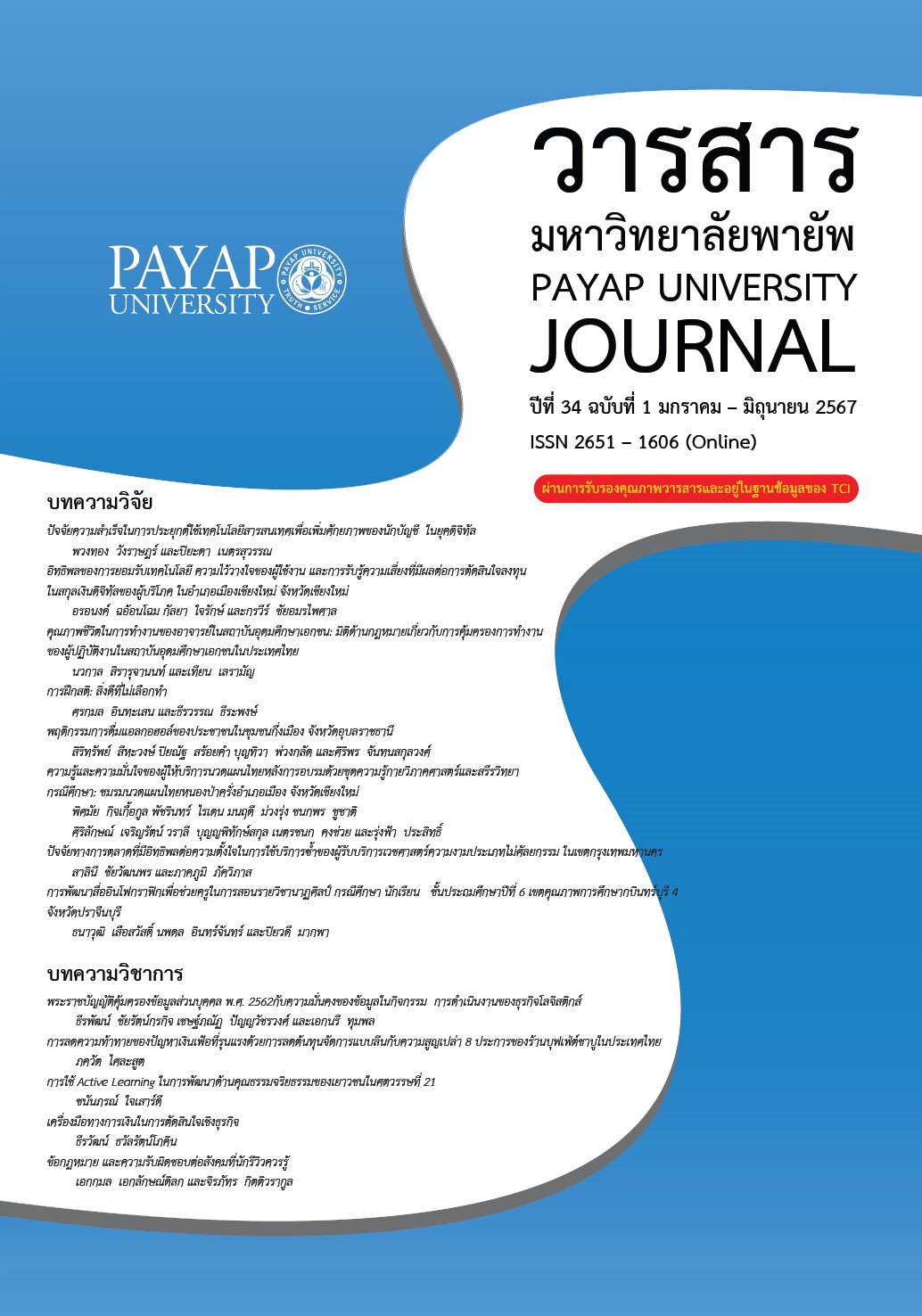การใช้ Active Learning ในการพัฒนาด้านคุณธรรมจริยธรรม ของเยาวชนในศตวรรษที่ 21
Main Article Content
บทคัดย่อ
บทความนี้มีจุดประสงค์เพื่อนำเสนอแนวทางการใช้รูปแบบการจัดการเรียนรู้แบบเชิงรุก หรือ Active Learning ในการพัฒนาคุณธรรมจริยธรรมของเยาวชนในศตวรรษที่ 21 โดยผู้ศึกษานำเสนอประเด็นผลกระทบของการเปลี่ยนแปลงจากความก้าวหน้าของระบบเทคโนโลยีสารสนเทศ ที่มีผลต่อชีวิตผู้คนในทุกด้านมาอภิปราย เพื่อให้สามารถปรับตัวและรับมือกับความเปลี่ยนแปลงในโลกยุคปัจจุบัน โดยเฉพาะอย่างยิ่งเยาวชน จำเป็นต้องเตรียมพร้อมที่จะเรียนรู้สิ่งใหม่เพื่อฝึกฝนตนเอง และจำเป็นต้องพัฒนาทักษะในศตวรรษที่ 21 โดยเฉพาะทักษะชีวิตในด้านคุณธรรมจริยธรรม อันจะช่วยส่งเสริมให้บุคคลมีจิตใจ ความคิด คุณลักษณะชีวิตและความประพฤติที่ดีงาม สามารถอยู่ร่วมกับผู้อื่นท่ามกลางสังคมและวัฒนธรรมที่หลากหลายได้อย่างสงบสุข การวิเคราะห์ด้านคุณธรรมจริยธรรมดังกล่าว สอดรับกับสภาวะจิตใจและพฤติกรรมของบุคคล ผู้ศึกษาได้ใช้ทฤษฎีทางจิตวิทยา คือ ทฤษฎีจิตวิเคราะห์ ทฤษฎีพัฒนาการทางสติปัญญา และทฤษฎีการเรียนรู้ทางสังคม เพื่อสังเคราะห์ ถึงจิตใจและพฤติกรรมของบุคคลซึ่งเป็นพื้นฐานสำคัญในการเสริมสร้างและส่งเสริมให้บุคคลนั้นสามารถพัฒนาสมรรถนะทางคุณธรรมจริยธรรม รวมถึงชี้ให้เห็นว่ากระบวนการจัดการเรียนรู้แบบเชิงรุก หรือ Active Learning เป็นกลไกสำคัญสู่การพัฒนาด้านคุณธรรมจริยธรรมแก่เยาวชนในโลกปัจจุบัน
Article Details
เอกสารอ้างอิง
กมล โพธิ์เย็น. (2564). Active Learning: การจัดการเรียนรู้ที่ตอบโจทย์การจัดการศึกษาในศตวรรษที่ 21(Active Learning: Learning satisfy Education in 21st Century). วารสารศึกษาศาสตร์ มหาวิทยาลัยศิลปากร, 19(1), 11-28.
กระทรวงศึกษาธิการ สำนักงานคณะกรรมการการศึกษาขั้นพื้นฐาน. (2562). แนวทางการนิเทศเพื่อพัฒนาและส่งเสริมการจัดการเรียนรู้เชิงรุก (Active Learning) ตามนโยบาย ลดเวลาเรียนเพิ่มเวลารู้. ผู้แต่ง.
จันทรา แซ่ลิ่ว. (2561). การจัดการเรียนรู้แบบเชิงรุก (Active Learning) ในรายวิชาการพัฒนาทักษะการคิดสำหรับเด็กปฐมวัย. คณะครุศาสตร์ มหาวิทยาลัยราชภัฏเชียงใหม่. http://cmruir.cmru.ac.th /handle/123456789/2012
ดุษฎี โยเหลา. (2557). การศึกษาการจัดการเรียนรู้แบบ PBL ที่ได้จากโครงการสร้างชุดความรู้เพื่อสร้าง เสริมทักษะแห่งศตวรรษที่ 21 ของเด็กและเยาวชน: จากประสบการณ์ความสำเร็จของโรงเรียนไทย. ทิพยวิสุทธ.
ทิศนา แขมมณี. (2557). ศาสตร์การสอน องค์วามรู้เพื่อการจัดกระบวนการเรียนรู้ที่มีประสิทธิภาพ. (พิมพ์ครั้งที่ 18). ด่านสุทธาการพิมพ์.
แบลเลนซาร์, เจมส์ และแบรนดท์, รอห์น. (2554). ทักษะแห่งอนาคตใหม่ การศึกษาเพื่อศตวรรษที่ 21 (วรพจน์ วงศ์กิจรุ่งเรือง และอธิป จิตตฤกษ์, ผู้แปล). Openworlds. (ต้นฉบับพิมพ์ปี 2553)
ปาริชาติ ธีระวิทย์. (2561). การเสริมสร้างคุณธรรมจริยธรรมสำหรับนักศึกษาระดับอุดมศึกษาในศตวรรษที่ 21. วารสารเทคโนโลยีภาตใต้, 11(1), 31-39.
ปราชญา กล้าผจญ. (2544). คุณธรรม จริยธรรม จรรยาบรรณวิชาชีพ. เยลโลว์การพิมพ์.
ปิยนันท์ สวัสดิ์ศฤงฆาร. (2556, 1 ธันวาคม). รูปแบบการพัฒนาคุณธรรมในองค์กร.http://oknation.nationtv.tv/blog/piyanan/2013/12/01/entry-1
ปิยะพล ทรงอาจ. (2562). การจัดการเรียนรู้เชิงรุก (Active Learning) โดยใช้เทคนิค STAD รายวิชา 810107 จิตวิทยาสำหรับครูของนักศึกษาหลักสูตรประกาศนียบัตรบัณฑิตวิชาชีพครู วิทยาลัยบัณฑิตเอเซีย.วารสารวิทยาลัยบัณฑิตเอเชีย, 9(ฉบับพิเศษ), 161-172. https://casjournal.cas.ac.th/admin/filedocuments/1578062429-21.ED087(161-172).pdf
ปิยะพล ทรงอาจ. (2563). Active Learning: การจัดการเรียนรู้เชิงรุก เทคนิคการสอนในศตวรรษที่ 21. วารสารวิทยาลัยบัณฑิตเอเชีย, 9(1), 136-143.
ประดินันท์ อุปรมัย. (2540). มนุษย์กับการเรียนรู้. ใน วิจิตร ศรีสอ้าน (บก.), เอกสารการสอนชุดวิชาพื้นฐานการศึกษา (ฉบับปรับปรุงครั้งที่ 15, หน่วยที่ 4, น.117-155). มหาวิทยาลัยสุโขทัยธรรมาธิราช.
ศักดา ไชกิจภิญโญ. (2548). สอนอย่างไรให้ Active Learning. วารสารนวัตกรรมการเรียนการสอน. 2(2), 12-15.
ศิริพร มโนพิเชฐวัฒนา. (2547). การพัฒนารูปแบบการเรียนการสอนวิทยาศาสตร์แบบบูรณาการที่เน้นผู้เรียนมีส่วนร่วมในการเรียนรู้ที่กระตือรือร้น เรื่อง ร่างกายมนุษย์ [วิทยานิพนธ์ปริญญาการศึกษามหาบัณฑิตไม่ได้ตีพิมพ์]. มหาวิทยาลัยศรีนครินทรวิโรฒ.
สิทธิพล อาจอินทร์. (2563). ศาสตร์และศิลป์การจัดการเรียนรู้ในศตวรรษที่ 21 (พิมพ์ครั้งที่ 3). คณะศึกษาศาสตร์ มหาวิทยาลัยขอนแก่น.
สุคนธ์ สินธพานนท์. (2558). การจัดการเรียนรู้ของครูยุคใหม่เพื่อพัฒนาทักษะผู้เรียนในศตวรรษที่ 21. 9119 เทคนิคพริ้นติ้ง.
อนิวัช แก้วจำนงค์. (2556). จริยธรรมทางธุรกิจ. (พิมพ์ครั้งที่ 2). นำศิลป์โฆษณา.
อ้อมเดือน สดมณี และ ฐาศุกร์ จันประเสริญ. (2554). การพัฒนาคุณธรรมจริยธรรม : จากแนวคิดสู่ แนวทางการปฏิบัติ. วารสารพฤติกรรมศาสตร์. 17(1), 2-14.
แอมโบรส, ซูซาน เอ. (2556). การเรียนรู้แห่งศตวรรษที่ 21: 7 หลักการสร้างนักเรียนรู้แห่งอนาคตใหม่ (วันวิสาจ์ เคน, ผู้แปล). โอเพ่นเวิลด์ พับลิชชิ่ง เฮาส์. (ต้นฉบับพิมพ์ปี 2553)
เฮ็นดริคส์, ฮาเวิร์ด จี. (2552). การสอนที่มีอานุภาพเปลี่ยนชีวิต (กนกบรรณสาร, ผู้แปล). กนกบรรณสาร. (ต้นฉบับพิมพ์ปี 2546)
Anderson, L. W., & Krathwohl, D. R. (Eds.). (2001). A Taxonomy for learning, teaching and assessing: A revision of Bloom’s taxonomy of education objectives (Complete Edition). Longman.
Freud, S. (1949). An outline of Psychoanalysis. W. W. Norton.
Meyers, C., & Jones, T. B. (1993). Promoting active learning: Strategies for the college classroom. Jossey-Bass Inc.
Power, F. C., Higgins, A., & Kohlberg, L. (1989). Lawrence Kohlberg's Approach to Moral Education. Columbia University Press.
Shenker, S.F., Goss, S. A., & Bernstein, D. A. (1996). Instructor’s Resource Manual for Psychology: Implementing Active Learning in the Classroom. n.p.


